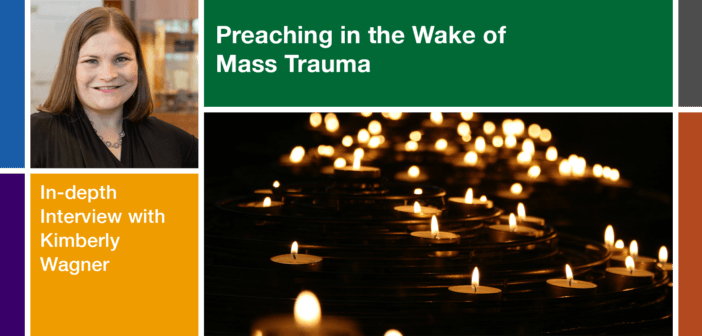How would you preach next Sunday if tomorrow your community fell victim to a mass shooting or was devastated by a natural disaster? Ann Michel of the Lewis Center staff interviews Kimberly Wagner, Assistant Professor of Preaching at Princeton Theological Seminary, about approaching this increasingly unavoidable homiletical task in ways that hold in tension loss and grief and the promise of God’s healing and redemption.
Listen to this interview, watch the interview video on YouTube, or continue reading.
Ann Michel: Anyone who watches the news can understand why preachers need to prepare themselves for the seemingly inevitable task of addressing mass trauma from the pulpit. But from a personal perspective, why did you to take on this subject? And what led you to write Fractured Ground: Preaching in The Wake of Mass Trauma?
Kimberly Wagner: Throughout my life and my professional life, I kept finding myself amid communities experiencing trauma. My first job was teaching tenth grade biology and eighth grade earth and space science in Cincinnati, Ohio, where a lot of students were experiencing trauma, poverty, and gang violence. During my time in seminary, I served for almost two and a half years as a student chaplain at a maximum-security women’s prison. And it deeply shaped my ministry, my life, and my questions. I found myself very much called to these communities experiencing trauma. I am ordained in the Presbyterian Church, U.S.A. Going into my first parish in Southeast Virginia, I thought, “I’ve had enough of communities experiencing trauma. I’m going to go to a congregation.” Well, as to be predicted, that congregation was dealing with a great deal of trauma that popped up in unexpected ways. For example, the Sandy Hook shootings in Newtown, Connecticut, happened while I was serving there. And for some of our congregants it was like it was happening in our backyard. It took me a while to figure out why. But some of our folks had been deeply affected by the Virginia Tech shootings and had never talked about it. It was something they didn’t think they could bring to church. Other issues around abuse, addiction, and grief popped up.
So, when I began my PhD work, I wanted to think about trauma. I was writing a seminar paper on preaching in response to mass shootings and when I looked for resources, there were none. There were lots of resources on trauma and pastoral care, trauma and psychology. But nothing on preaching. So, my advisor and peers all said, “Maybe you should write it.” And the more I dug into it, the more I felt called to this work. So, my academic work was accompanied by a deep sense of call that integrated the intellect and the heart. It really comes from a pastoral space.
Ann Michel: Before we get into your recommendations for preaching in the wake of mass trauma, you identify some less-than-helpful ways that preachers often respond to community crises. Could you quickly name some of those as a starting point?
Kimberly Wagner: Absolutely. But first I want to say that, even when preachers respond in less-than-helpful ways, they do it out of a genuine sense of care and a desire to help. None of us have been trained to teach and preach and minister in these times when we are encountering trauma after trauma — often interacting and exacerbating collective trauma. But the first less-than-helpful way preachers are inclined to respond is to just lament, to throw up their hands and say, oh, my goodness! There is nothing hopeful, good, lovely, or faithful to say in this moment. So, all we can do is just cry out to God together.
The second less-than-helpful response is at the other end of the spectrum — to just offer platitudes and recite all the faith statements they’ve always said. “God’s got it.” “It’ll be okay in the sweet by-and-by.” These preachers almost stack faith against the pain hoping that, if they can outspeak the pain, their platitudes will be true.
Then the third way is that they just ignore it. I think this is less and less an option, but historically many preachers confronted with this situation think: That doesn’t belong in church. I don’t even know how to begin to address this in the pulpit, so I’m not going to. Or its not in the lectionary for today; I plan my sermons out. Interestingly, when I talk to preachers who don’t want to talk about these things in the pulpit, it’s less that they don’t know what to say or that they don’t feel like it. It’s fear of really wrestling with the elephant in the room.
For example, one of my Doctor of Ministry students lost a young woman in her church to a stray bullet. She was reluctant to mourn that loss. She said, “We sit in a pew and hear gunshots outside the window. Gun violence is not something that we don’t think is happening.” But I asked her, “What would it mean to talk about gun violence in holy spaces or to take the sacred time of the sermon, of prayers, to name that brokenness and to add faith language to it?”
Ann Michel: You write that preaching in the wake of mass trauma must address the eschatological tension between what’s been broken and lost on one hand and the anticipation of God’s promised hope on the other hand. Can you speak a bit about how to strike that balance?
Kimberly Wagner: We need to resist the urge to collapse. I write about sitting in this eschatological tension. On one side: death, loss, brokenness. On the other side: hope, resurrection, and redemption. And I think the errors that we talked about are the tendency to collapse that tension. Now, preaching in that tension doesn’t mean right down the middle. There are times when we don’t rush to hope, promise, and resurrection, particularly in the immediate aftermath. We may find ourselves preaching over toward the death and loss side, but still holding that thread of hope. I tell my students that sometimes all we can hold out is the promise of hope that we have not yet experienced, a theology that says that hope is coming, that God is coming.
I think a lot about the prophet Habakkuk standing on the rampart, lingering, and saying in the midst of the destruction of the city, “I will wait. I’m going to stand on the rampart and see what God will yet say.” And I ask my students, where in this tension are you preaching and how is that appropriate to where your congregation is? Because it’s not a progression from one end to the other. You don’t start at the pain and death and loss side and gradually work your way to the hope and resurrection side. This isn’t a one-way street. It’s a tension we continually navigate. Because anniversaries come up. Holidays come up. Court cases start. Another shooting happens. And all of a sudden, the grief of that loss is fresh and new in very real ways. These things will pull your congregation back towards perhaps needing you to preach more on that death and loss side than the resurrection hope side, but always holding the tension and resisting the collapse.
Ann Michel: In your book, you explore two prototypes of how to structure a trauma response sermon. They differ, but in both models the goal isn’t to tidy everything up or make sense of everything. In both cases, it’s okay to leave some open questions.
Kimberly Wagner: Early in the book, I offer the language of narrative fracture. Communities and individuals experiencing trauma also experience narrative fracture. The stories they tell about themselves and the world and their communities and their families and even God don’t hold together anymore. So, how do we respond faithfully to individuals and communities experiencing narrative fracture?
I think it matters that we honor and pay attention to narrative fracture in sermon form as well. We want to say, “I can fix this. I can make these stories whole again.” We rush toward that because it feels good and healthy. And we want to get through the process and check it off our list. But the reality is that our preaching in both its content and its form can let people who are experiencing narrative fracture know that their experience is not beyond the grace and love of God, not beyond the biblical witness, and not beyond the community. In fact, in modeling this in our preaching, in modeling narrative fracture in the ways we even put our sermons together, we can do this work of blessing. We can also model healthy and faithful trauma response.
Ann Michel: I think when a crisis occurs, even in our very, very secular age, people beyond the church turn to the faith community for solace, to make meaning of it. What the church says in the face of tragedy is not just a matter of congregational care. It’s also an act of public witness and even evangelism. So, I’m wondering if there isn’t a much broader audience for preaching in the wake of traumatic events than the congregation typically gathered on a Sunday morning? And how can a preacher take into account this much wider audience for their words, an audience that’s probably less theologically sophisticated and less biblically literate than their normal churchgoers?
Kimberly Brown: If I could rename my book, I would title it Fractured Ground: Proclamation in the Wake of Mass Trauma. When I think about the audience for this book, the first row of the room is Sunday morning preachers who have patterns and ways of speaking that are suddenly thrown into chaos following a mass traumatic event. I think that the second row is other community leaders who have to speak into these situations. One of the things I did not want to lose in this book is the public witness piece, the idea that the preacher and the church and our faith still have something to say in these moments and that it is an opportunity for public witness. I think the preacher is called upon to model well this faithful trauma response, which we see again and again in Scripture. So, I do think it is an opportunity for the church. I think it is the place where the church probably gets the loudest hearing in today’s world. When literally all hell breaks loose is one of the few times that people who are not regularly in church look and ask, “Is there a word from the Lord?”
Ann Michel: I think one of the most important messages in your book is the idea that you can’t wait until a disaster or crisis happens to think about how you might preach in response to it. So beyond reading your book, are there other simple steps working preachers can take to prepare themselves for the time when disaster might come to their community?
Kimberly Wagner: When it happens, we don’t have time, so we need to be prepared. A few things to think about. First, as you preach week to week, think about using trauma lenses to look at some of the texts. Practice looking for where you see trauma at work in Scripture. And if you see something, don’t just save it for later. Preach it. It doesn’t have to be every week.
Practicing it over and over builds a vocabulary held in trust for us and for our communities when we need it. This language and these skills are not something you put on the shelf and pull out when you need them. You keep practicing what it means to preach in the tension. You make sure that not every sermon has a “happily ever after” ending. What does it mean to tell stories in our preaching that aren’t easily resolved? What does it mean to hold in tension some of the things that are hard to reconcile in our biblical texts, to model and to practice what we have to do when we encounter trauma? What does it mean to hold that eschatological tension in our day-to-day work so that we’ve exercised those muscles?
Second, I encourage you to get clear about your theology. For example, when communities experience natural disasters, people ask: Does God speak through nature? Does God correct or is God punishing us? Did God just create the world and walk away and has no control over nature? Is God choosing not to keep us safe? It’s important that faith leaders are clear about their own theology. Because your community is not thinking about these questions until it hits them.
Third, it is so important for pastors and preachers to build communities of support. Let’s be clear, when a mass traumatic event happens, the preacher is going to experience the trauma alongside the community. And one of the lies that trauma whispers in our ear is that our pain is unique, we are alone, and nobody can help us. I cannot tell you how many preachers and pastors I work with say that in responding to a trauma they felt totally alone in leading the community. So, creating communities of support and care and coworkers in the in-between times will help combat some of that desire to become the community superhero. You don’t have to lead them alone. You not alone in supporting them, so cultivate communities of support. Get connected to organizations and groups that can help you and help you support your community. Nurturing those relationships is key.
Related Resources
- Preaching in the Wake of Mass Trauma featuring Kimberly Wagner — Leading Ideas Talks podcast episode | Podcast video
- Does Your Church Need a Disaster Ministry Plan? by Jamie D. Aten and David M. Boan
- 10 Things Great Preachers Do Differently by Charley Reeb






